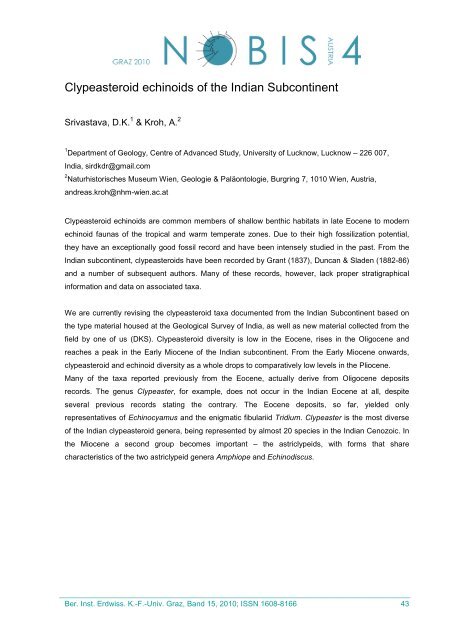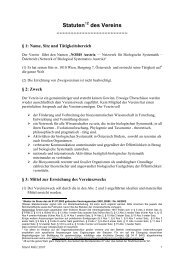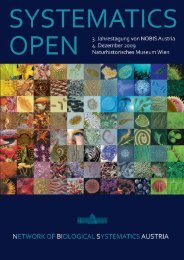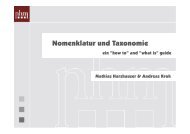4. Jahrestagung von NOBIS Austria 2. - 3. Dezember 2010
4. Jahrestagung von NOBIS Austria 2. - 3. Dezember 2010
4. Jahrestagung von NOBIS Austria 2. - 3. Dezember 2010
Create successful ePaper yourself
Turn your PDF publications into a flip-book with our unique Google optimized e-Paper software.
Clypeasteroid echinoids of the Indian Subcontinent<br />
Srivastava, D.K. 1 & Kroh, A. 2<br />
1 Department of Geology, Centre of Advanced Study, University of Lucknow, Lucknow – 226 007,<br />
India, sirdkdr@gmail.com<br />
2 Naturhistorisches Museum Wien, Geologie & Paläontologie, Burgring 7, 1010 Wien, <strong>Austria</strong>,<br />
andreas.kroh@nhm-wien.ac.at<br />
Clypeasteroid echinoids are common members of shallow benthic habitats in late Eocene to modern<br />
echinoid faunas of the tropical and warm temperate zones. Due to their high fossilization potential,<br />
they have an exceptionally good fossil record and have been intensely studied in the past. From the<br />
Indian subcontinent, clypeasteroids have been recorded by Grant (1837), Duncan & Sladen (1882-86)<br />
and a number of subsequent authors. Many of these records, however, lack proper stratigraphical<br />
information and data on associated taxa.<br />
We are currently revising the clypeasteroid taxa documented from the Indian Subcontinent based on<br />
the type material housed at the Geological Survey of India, as well as new material collected from the<br />
field by one of us (DKS). Clypeasteroid diversity is low in the Eocene, rises in the Oligocene and<br />
reaches a peak in the Early Miocene of the Indian subcontinent. From the Early Miocene onwards,<br />
clypeasteroid and echinoid diversity as a whole drops to comparatively low levels in the Pliocene.<br />
Many of the taxa reported previously from the Eocene, actually derive from Oligocene deposits<br />
records. The genus Clypeaster, for example, does not occur in the Indian Eocene at all, despite<br />
several previous records stating the contrary. The Eocene deposits, so far, yielded only<br />
representatives of Echinocyamus and the enigmatic fibulariid Tridium. Clypeaster is the most diverse<br />
of the Indian clypeasteroid genera, being represented by almost 20 species in the Indian Cenozoic. In<br />
the Miocene a second group becomes important – the astriclypeids, with forms that share<br />
characteristics of the two astriclypeid genera Amphiope and Echinodiscus.<br />
_____________________________________________________________________________<br />
Ber. Inst. Erdwiss. K.-F.-Univ. Graz, Band 15, <strong>2010</strong>; ISSN 1608-8166 43






